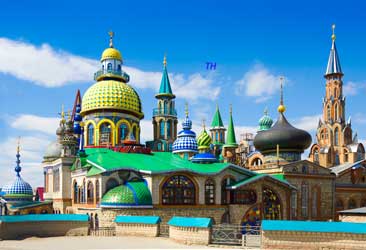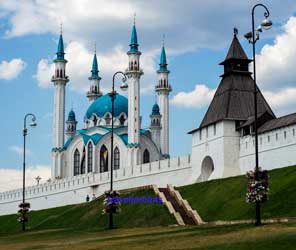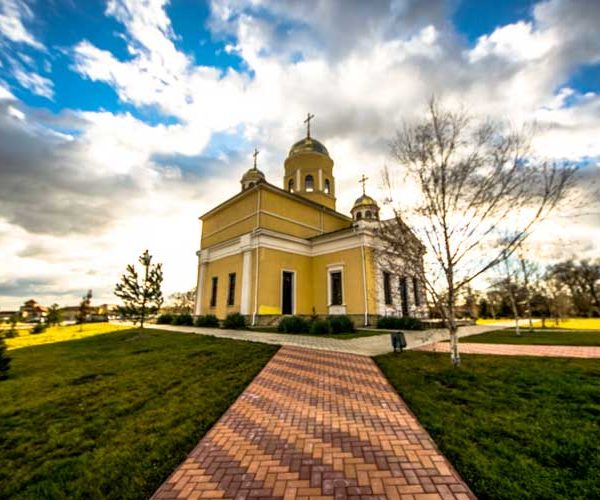Kazan is one of the oldest cities in the Russian Federation. It is the capital of the Tatarstan Republic, situated on the left bank of the Volga River where it meets the Kazanka River.
The city historically grew up assimilating two different world cultures – the Wise Eastern culture with its magical fairy tales and magnificent regalia; and the Practical West with its business acumen and economic activity.

Kazan is the city of contrasts. The ancient architecture here is found side by side with modern aspects. The charming atmosphere is then strengthened with its magic picturesqueness. The most ancient building in Kazan was put up in the mid-16th century. Peter the Great celebrated his 50th anniversary in it.
One of the largest mosques in Europe is situated in Kazan. It was named after the head of Muslims of Kazan – Khan Khul Sharif who died defending his khanate. In general, Kazan is a multi-religious city. There are more than 20 mosques, Orthodox churches, Protestant churches, a Catholic chapel, a Judaic synagogue and other religious institutes.
Kazan is famous for its rich cultural life: here you can visit the International Opera festival named after Fedor Shalyapin and also the International ballet festival named after Rudolf Nuriev. You can feel unique traditions of Tatar people during the summer festival Sabantuy.
Kazan has a lot of sightseeing that can be interesting for every tourist: ancient Kazan Kremlin which is on the UNESCO World Heritage list, the third oldest university in Russia, one of the famous leaning towers in the world – the Söyembikä Tower.
The highest fountain in Kazan is situated in the centre of the city on Lake Kaban. There is also a three-levelled light and music complex of dancing fountains. In Kazan, there is a house where famous Gala, Salvador Dali’s wife was born.
Kazan’s architecture has a lot of images of the dragon Zeelant. It can be found also on Kazan’s coat of arms. The dragon is a symbol of power and creation for the benefit of people. 
Kazan has the official status of the third capital of Russia after Moscow and St. Petersburg. Еthe unofficial status of the city is the Sports capital of Russia. Kazan hosted the World Students Games in 2013 and the World swimming championship in 2015.
Kazan, with its impressive Kremlin, mosques, churches and museums, is a unique tourist destination. At the same time, it is an incredibly comfortable, beautiful and cosy modern city. It has excellent facilities for tourists: new hotels, including international hotel chains, have been built, many historical buildings were renovated, sports facilities and public transportation were considerably improved. In 2014 Kazan became the third popular tourist destination in Russia.

Kazan Kremlin is the main site of the city of Kazan. This open-air museum is considered to be the most valuable cultural heritage site of the Republic of Tatarstan. The Tatar fortress preserves original city-planning ideas of architectural complexes. Still, its territory shows the historical interaction of different architectural cultures – the Medieval Tatars, Golden Horde and Ancient Rus.
The architecture of Kazan Kremlin is a representation of both Tatar and Russian styles. It is situated on the left bank of the Kazanka River. The whole territory occupies an area of about 15ha. The open-air museum consists of several constructions: Kazan Kremlin itself (dates back to the 10th century), stone Kremlin (dates back to the 16th century) and other architectural constructions (dated to 16th-19th centuries).
Special attention should be given to the leaning Tower of Syuimbeke which is mentioned in numerous myths and legends. Besides that, there is a row of museums and expositions – Museum of the Tatar people and Islamic culture, the centre Hermitage-Kazan, the Museum of the history of Tatarstan, Museum of Fine Arts of Tatarstan, Art Gallery and the Museum of the Great Patriotic War.
Kazan Kremlin open-air museum is the unique historical landmark, which is under the protection of UNESCO.
Tower of Syuimbeke is the famous tower in Tatarstan that has been leaning to one side for hundreds of years and still hasn’t fallen down.
One of few leaning towers in the world is situated in Kazan Kremlin. It is known to be built in the 17th century but the architecture is unknown. Tower of Syuimbeke is 58 metres high and its inclination is 1.8 metres. Because of some changes in the foundation, the construction had leaned to the south-east almost right after its construction. However, it was mentioned in the 20th century only.
The Tower’s history is wrapped in mystery which is still a matter of heated discussion. However, there is no detailed information about this site because of the fire in 1701 which destroyed all the records. One of the legends has it that the Tower was built in honour of the beautiful Tatar tsarina Syuimbeke who was considered a wise and fair governess. However, historians say that the Tower was constructed as a defensive fortification and it provided an excellent view of 50 metres around. That helped the citizens to get an advance warning about any danger and to be ready to hold off an enemy attack.
During Soviet times, the Tower of Syuimbeke was renovated. Due to digging works nearby, there were ancient coins found. Those were remains of a mosque and khan’s shrines and pieces of headstones with engravings. Since 1994, all the territory of Kazan Kremlin where Tower Syuimbeke is situated has been declared to be a historical open-air museum.
The Temple of All Religions is a unique landmark and the last masterpiece of a humanitarian artist.
The artist Ildar Khanov started building the temple on his garden plot in 1994. This unique building combined the features of Catholic, Orthodox and Buddhist temples, as well as mosques and synagogues. Being situated not far from the city of Kazan, the construction was not originally planned as a religious centre but as a complex with a museum, concert hall and an exhibition gallery.
Honoured Artist Ildar Khanov believed that God is one and for everybody and didn’t want to separate religions. He planned to unite 16 religions of different peoples in the world in his creation, which he called the Universal Temple. This construction is not meant to serve for religious purposes, but to people. The creator also wanted to build a theatre there, a school of arts for children, a war memorial and even a drug intervention.

Ildar Khanov didn’t have any own savings so he raised the money to build the Temple. Unfortunately, he died after an extended illness in 2013. The Temple of All Religions isn’t finished yet and it is being built up till now.
The Mosque Khul Sharif is the main mosque of the Republic of Tatarstan. It is situated in the territory of Kazan Kremlin.
The original mosque of Kazan Khanate was levelled to the ground during the capture of Kazan by the troops of Ivan the Terrible. Khul Sharif, built in 1996, is a complete copy of the original mosque. Building construction cost about 500 mln rubles that were mostly donated by people and organisations. The mosque was open on 24th June 2005, the day of the 1000th Anniversary of Kazan city. The Mosque Khul Sharif can hold up to 1500 people at a time.
The square near it can hold another 10 000 praying people. The mosque is decorated with marble from the Urals. The carpets that decorate the interior are the gift from the government of Iran. The mosque is also decorated by an amazingly beautiful chandelier made by Czech craftsmen. Huge lancet windows are filled with skilful glass paintings which give the interior some special beauty. Visitors can learn more about the Mosque Khul Sharif and the Tatar culture during everyday educational excursions.
Palace Square in Kazan is an incredibly beautiful place in the very centre of the city. It has several names. Some people call it the Palace Embankment because it is situated near the Kazanka River. Others are used to the name Fedoseevskiy Park (in connection to the street nearby). Still, it doesn’t matter what name it has, the square can’t lose its greatness.
It is surrounded by the ancient whitestone walls of Kazan Kremlin. The Palace Square is always crowded because all the visitors and tourists who come to this very place to enjoy the views and take amazing photos. Nowadays it is the most attractive place in Kazan. Although, not many people know that in Soviet times, the square was called “rotten swamp” and hosted run-down houses which didn’t have any historical value.
In the 2000s those teardowns were destroyed and their place was taken by great buildings such as, for example, the Palace of Farmers. The Palace Square is paved with decorative plates. There is an artificial pond and also lots of colourful flowerbeds. In the evening, you can have a romantic walk in a magic light of lanterns.
Square of Tukay is the central square of Kazan. It has changed its name several times. Nowadays it is named after the Tatar poet Gabdulla Tukay. However, the citizens call it “The Ring”.
The square was founded in the 18th century on the place of a swamp. It was rebuilt and widened many times. It was finally pebbled, then there were launched horse trams and at the end of the 19th century – electric trams. Since that time the square is the crossing of the most routes of public transportation.
The architecture of the square includes lots of different constructions built in a range of styles from modern to high-tech. There are many remarkable and significant buildings, such as the former Central Telegraph Office, the main building of the Kazan Financial Institute, some Stalinesque houses, entertainment centres and hotels. There won’t be any problem to get to the square as well as to get to any place in the city from the square.
If you are lucky to visit the Square of Tukay don’t lose your chance to go shopping and enjoy yourself in the shopping and entertainment centre “The Ring”.
A real architectural miracle – Alexandrovsky Passage – impresses with its exterior. The renovation is going to be finished soon and this building that has a very tough fate will be opened for visitors.
Alexandrovsky Passage was built at the end of the 19th century. The builders used the most advanced technologies of that time. Passage occupied the whole quarter and had a glass roof, air heating, an elevator and even electrical lights – all those things were real miracles for that time.
The merchant Alexandrov invested a lot of money into the project but didn’t get any profit. The maintenance of the building required much more money then it could earn so the merchant had to sell it.
The passage hosted workshops, shops and offices. At the beginning of the 20th century, there was an electrical theatre that was considered to be the “pearl of Kazan” – so elegant and magnificent it was. Because of an incorrect use of the building, the elevator and the clock on the dome stopped forever. It is said that during the merchant Alexandrov’s life the clock stopped three times – when he got married, when his daughter was born and when he died.
Unfortunately, regular floodings in the basement caused some part of the building to destroy. It is still under reconstruction now but the plan is to open a hotel there in the year of 2018.
The fountain on the Nizhny Kaban Lake is the main and one of the largest city fountains in Kazan. It is situated on Nizhny Kaban Lake, on the square near the theatre named after G. Kamal. There are a lot of legends about this lake. One of those was even filmed. The fountain is constructed on the water surface. The visitors can enjoy the view of it from early morning till late at night. The fountain is usually dismantled for winter time but in the summer visitors can admire it again.
The National Museum of the Republic of Tatarstan is the largest scientific-research and educational institution in Tatarstan that preserves a valuable artistic, cultural and literal heritage of the Republic.
The National Museum was founded at the end of the 19th century. The basis for it became a large private collection of a famous archaeologist and historian A. Likhachev. The collection was later enlarged by eminent scientists and philanthropists. Nowadays the funds of the museum contain about 800,000 unique items which have a great value for Russia. The most valuable exhibits are an ancient collection of gold coins, elder scrolls, manuscripts and a lot of memorabilia of Tatar writers.
Nowadays the museum has 14 branches and is the largest science centre for 400 museums that are situated in Tatarstan. The National Museum of the Republic of Tatarstan is equipped with the newest depository, restoration workshop and has a very complicated infrastructure. It regularly hosts festive events and literary meetings.
Search Best Hotels Here
 TravellerHints!
TravellerHints! 


